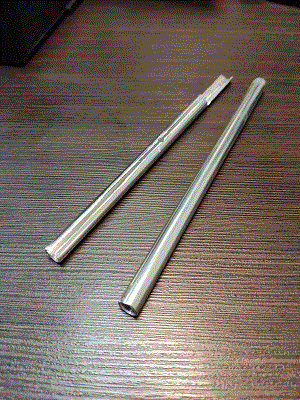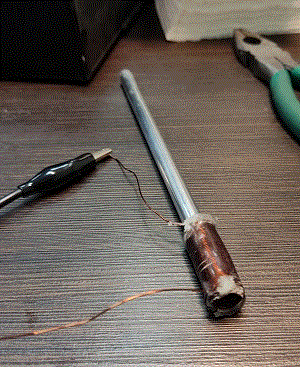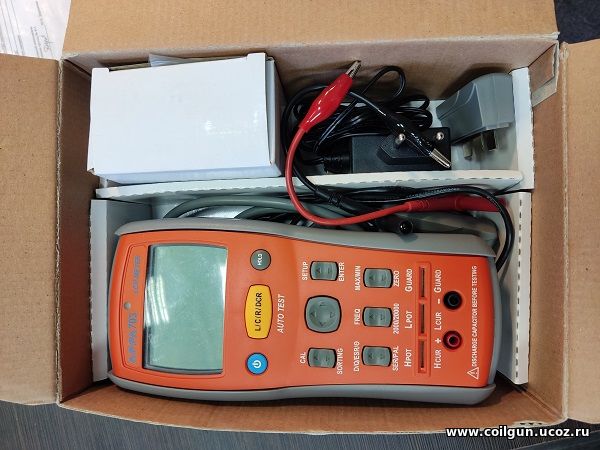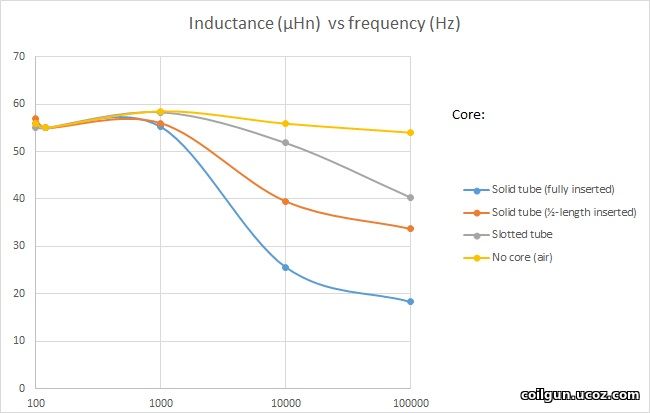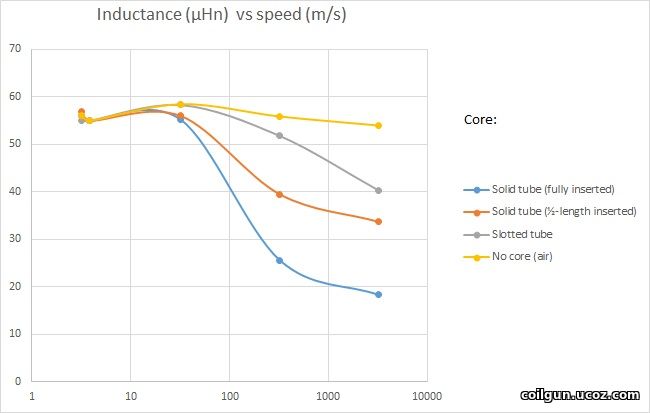| Home » Articles » Experiments » Other |
Quite a long time ago I published an article on the influence of cores of various types on the inductance of the winding at high magnetic field strengths. In it, I got interesting results that can be used to evaluate the effects associated with the movement of ferromagnetic projectiles in the coils of coilguns. However, many gauss-builders are also interested in the question of the effect on the efficiency of an electromagnetic accelerator of such an element as a barrel. The fact is that for its manufacture there is a temptation to use cheap metal tubes made of brass or aluminum, in which, however, undesirable eddy currents (or, as they are also called, Foucault currents) may occur. Let me briefly recall the essence of this effect.
Fig. 1. The origin and manifestation of the eddy currents.
Eddy currents occur in any conductive object placed in an alternating magnetic field (for example, in a metal core or tube placed inside an alternating current coil). Since, according to the law of electromagnetic induction, the direction of these currents is opposite to the direction of the field source currents, a repulsive force arises between them (see Fig. 1). In practice, this leads, for example, to the fact that a cylindrical magnet is strongly braked when moving inside a copper tube. Below is a video from YouTube, where this effect is demonstrated.
It is not difficult to realize that this case is very similar to the situation that we have in any coilgun - a magnetized iron bullet moves inside the tube, over which the accelerating coils are wound, and if the tube is made of a good conductor, then eddy currents will hinder this movement, that is, reduce the efficiency of our accelerator. Interestingly, as a counteraction measure, it is often proposed to make a longitudinal cut in the tube, preventing the flow of currents along a closed circuit. However, even in this case, braking is possible - it is enough just to have a massive conductor nearby a moving magnetized body. In this case, eddy currents are closed not around the core, but somewhere near it, however their effect can still be noticeable. Watch the last part of the above video - the magnet greatly slows down its fall even if it is simply placed between two massive metal strips. In addition, it is obvious that Foucault currents in a conductive tube placed inside a winding with an alternating (in our case, pulsed) current will lead to shielding of the effect of this winding, and not only on the core inside the tube, but also on the coil itself, that is, reduce its inductance. It was this effect that I decided to use for my experiment. As samples, a coil with a length of about 32 mm was used, as well as two segments of the same duralumin tube with an outer diameter of 8 mm and an inner diameter of about 6 mm, one of which was slotted along the entire length (see Fig. 2).
Fig. 2. Experimental samples.
Then the inductance of the winding was measured in various cases - without a core, with a solid tube inserted for half the length of the coil (see Fig. 2 on the right), with the same tube inserted for the entire length, and finally, with a sawn tube inside. Measurements were carried out at various frequencies with a decimal pitch from 100 Hz to 100 kHz (below I will explain why this was done). The device APPA 703, shown in Fig. 3, was used for the measurement.
Figure 4 shows the measurement result as a dependence of the inductance on the frequency of the test signal for each case.
Fig. 4. Inductance of the coil with different cores vs test frequency.
It can be seen that the inductance significantly depends on the frequency, and has its maximum for a solid tube core, and the minimum in case of the core's absence (here the inductance variation in the entire range does not exceed 2 ... 3% and is most likely due to measurement error). By itself, this dependence is understandable - the higher the frequency of the test current in the coil (i.e., the time derivative of the magnetic field strength dH/dt), the more intense the eddy currents. Interestingly, the introduction of a cut does not completely suppress their influence. The effect is noticeable even if the core does not occupy the entire length of the coil, but only half of it. Note that the duralumin is not a ferromagnet, and its response should be similar both under conditions of small excitations (as is the case with measurements by our LCR meter) and in the case of real coilgun, where currents in the windings can reach hundreds and thousands of amperes. Therefore, the results obtained can be directly applied to assess the influence of metal barrels in coilguns. To do this, it is convenient to give the dependences of Fig. 4 not vs the frequency, but vs the velocity of the projectile. It is very simple to do this: since we know the length of the coil l, the time of motion of the accelerated body of the same length through it at a speed v will be T = l / v, which corresponds to the frequency of the current f = 1 /T. This is where measurements in the frequency range will come in handy. The results of such recalculation are shown in Fig. 5.
Fig. 5. Inductance of the coil with different cores vs speed of the core.
Several important conclusions can be drawn: - the introduction of a metal barrel significantly reduces the inductance of the coil (and, consequently, the magnetic coupling of the coil and the core, which is actually a measure of the efficiency of the electromagnetic accelerator). At the same time, the introduction of a slot reduces this effect, but does not completely eliminate it. In addition, even partial "shading" of the coil with a conductive barrel can give a significant negative effect. Nevertheless, up to speeds of about 300 m/s (apparently, the limit for portable colgans), the use of slotted metal barrels is quite possible (although the strength of such structures is questionable). - the effect of eddy currents is practically not noticeable up to a speed of 30 m/s (for any barrel configuration), and is very small up to 50..60 m/s. Therefore, a solid metal barrel can be used for low-speed gauss-guns.
In conclusion, it can be noted that the considered effect should significantly depend on the thickness of the walls of the metal tube in question - with its increase, eddy currents will meet less resistance and reach a higher value. In my experiment, I took a fairly thick tube (the wall thickness is 1 mm with an outer diameter of 8 mm), i.e. the results obtained are most likely close to the worst case.
Sincerely Yours, | |||||||
| Views: 242 | | | |||||||
| Total comments: 0 | |


